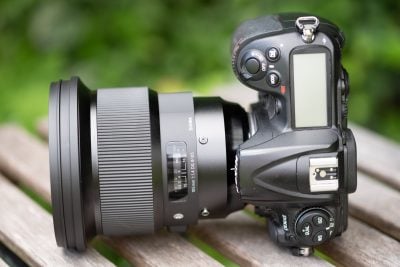Sigma 105mm f1.4 Art review
-
-
Written by Thomas
In depth
The Sigma 105mm f1.4 Art is a bright mid-length telephoto lens corrected for full-frame sensors and available in Canon, Nikon and Sigma DSLR mounts, as well as in a native Sony E mount for Alpha mirrorless cameras. With an f1.4 focal ratio the new 105mm f1.4 Art joins the Nikon 105mm f1.4E as the brightest lenses at this focal length, although crucially the Sigma comes in at a lower price and with the benefit of availability in more than just a Nikon mount.
Available since July 2018, it has no predecessor in Sigma’s lens catalog. To be included into Sigma’s acclaimed Art series of top-notch lenses it should have very good optical performance and build quality. And as you would expect it is compatible with Sigma’s USB-dock to fine-tune various characteristics of AF, plus if you change bodies, you can pay to have the mount swapped for your new system. This all comes at a price: 1400 USD / 1500 EUR is not exactly cheap but roughly in line with other high performance large aperture mid-length telephoto lenses – and again it’s also more affordable than Nikon’s own 105mm f1.4 lens, so one of the big questions I’ll be answering in my review is how these two models compare.
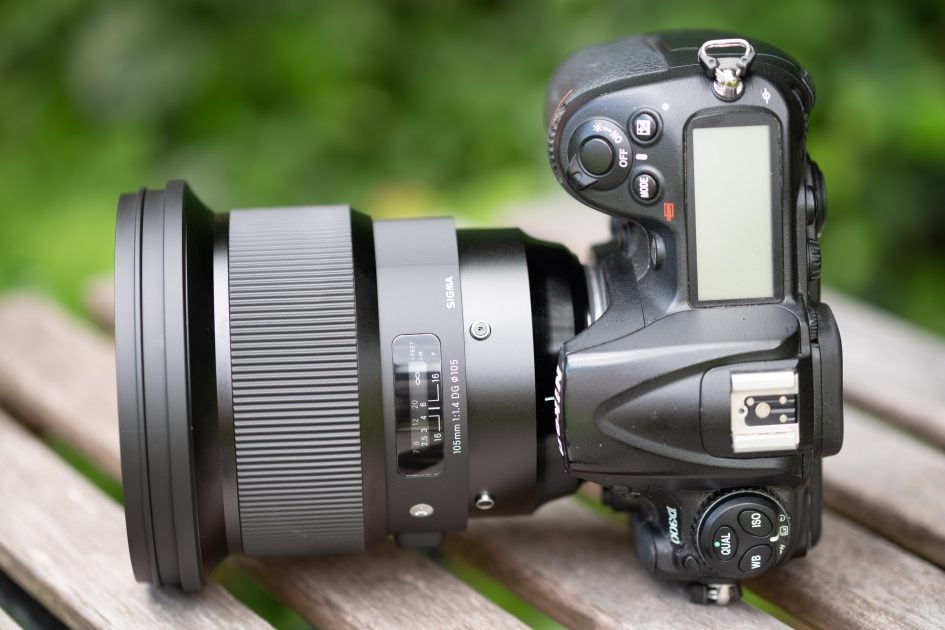
Facts from the catalog
As usual I’ll have a look at the technical data of the Sigma first. I’ve rated the features with a [+] (or [++]), when it’s better than average or even state of the art, a [0] if it’s standard or just average, and [-] if there’s a disadvantage. For comparison I use the Nikon 105mm f1.4E (“Nikon” for short) and Sigma’s own 135mm f1.8 Art (“Sigma 135mm”).
Size (diameter x length): 116 x 129mm, the lens hood adds 43mm (with a diameter of 128mm) which gives a total length of 172mm. The Nikon is 95 x 106mm with the lens hood adding another 47mm (111mm diameter). The Sigma 135mm is 91 x 114mm, the lens hood adds 60mm (with a diameter of 102mm). [0]
Weight: 1496g plus 104g for the carbon fiber lens hood and 123g for the detachable tripod collar which adds up to a total weight of 1723g. The Nikon is 979g, the lens hood adds another 55g. The Sigma 135mm comes in at 1121 + 64g. So the new Sigma 105mm f1.4 is by far heavier and larger than the alternatives except for the Mitakon 135mm f1.4. [-]
Optics: 17 elements in 12 groups vs. 14 elements in 9 groups for the Nikon and 13 elements in 10 groups for the Sigma 135mm. This is a complex design for a prime lens and contains 5 special dispersion elements and one aspherical lens element which could produce onion rings in out-of-focus specular highlights. The Nikon and the Sigma 135mm have no aspherical elements. [+]
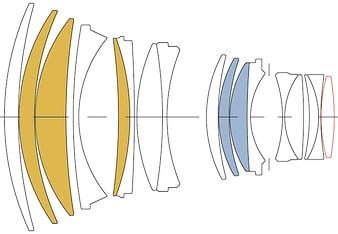
Closest focus distance is 1.0m with a magnification of 1:8.3 although I was able to get down to 1:7.7 at 0.94m with manual focus. A magnification of 1:10 is achieved at a distance of 1.18m. The Nikon does 1:6.7 at 0.92m in manual focus and and achieves 1:10 at 1.26m while the Sigma 135mm goes to 0.84m where it offers a very nice magnification of 1:4.6 and achieves 1:10 magnification at 1.55m distance. [0]
Filter-thread: 105mm which probably means that you will need an expensive new filter set. The Sigma 135mm and the Nikon need cheaper 82mm filters. [-]
Image stabilization: No. That’s about par for the course on large aperture primes. Unfortunately at a focal length of 105mm and with today’s high resolution sensors it’s pretty challenging to avoid blur/shake with hand-held shots. Use 1/200 sec to be on the safe(r) side or use a tripod. Canon has proven that you can build f1.4 primes with image stabilization and not compromise image quality for it. And Sony offers at least body-based image stabilization. [0]
Auto focus: HSM (Hyper Sonic Motor), so it also works on camera bodies which don’t have an AF-drive built in like Nikon’s D3x00/5×00. Manual-focus override is by simply turning the focus ring. Same with the Nikon. But the new Sigma allows you to alter focus fine-tuning at 4 distances with the USB-dock. The Sigma 135mm is the only lens in this comparison which has a limiter switch (full / 1.5m – infinity / 0.875 – 1.5m configurable with the USB-dock). [+]
Covers full frame/FX or smaller = very good. Same with the competition. [+]
Price: around 1500 EUR (incl. 19% VAT) / 1600 USD. The Sigma 135mm has a street price of around 1250 EUR / 1400 USD and the Nikon is around 2000 EUR / 2200 USD. [0]
Comes with a nice padded lens case and a strap. The lens hood is included, made from carbon fiber to reduce weight, and has a rubberized front segment to prevent dings and scratches from setting the lens down on the lens hood. It is reversible for transport, and can be locked in place with a screw. The lens-caps are standard. The lens comes with a detachable tripod mount with an Arca-Swiss style interface. No other f1.4 lens offers that except for the elusive Mitakon 135mm f1.4. Sigma even included a rubber ring to cover the tripod mounting screws on the lens should you prefer to leave the tripod mount detached. [++]
Distance information is relayed to the camera, so the camera and flashes can do all the advanced exposure-related stuff with this lens. Same for the alternatives. The Canon version of the lens is also compatible with the lens aberration corrections available in recent bodies to compensate for vignetting, chromatic aberrations and distortion. [+]
Sigma’s service can change the mount of the lens between Nikon, Canon, Sony or Sigma (at a cost). Plus you can also buy Sigma’s MC-11 Mount Converter for 250 EUR/USD to put the lens on a Sony E-Mount body (only available for adaptation of Sigma lenses with Sigma or Canon mount, not Nikon mount). These are unique feature that no other manufacturer offers. [++]
Aperture ring: no, same as with the competition. The aperture is actuated electromagnetically in the Nikon-version too which makes it the equivalent of a modern E-type Nikon lens and puts away with the mechanical coupling that Nikon uses on all older lenses. [0]
Sealing: yes, a rubber grommet at the lens-mount plus further special weather-sealing throughout the construction. The Nikon and the Sigma 135mm only have weather sealing at the lens-mount. [+]
The score in the “features-department” is 2[-]/5[0]/9[+]. So the lens is well-featured with the unique option to get the lens-mount swapped or use an adapter for Sony’s E-Mount plus a detachable tripod collar which no other manufacturer offers. The two big downsides are its weight and size and the need to use 105mm filters.
Three large aperture medium telephoto lenses
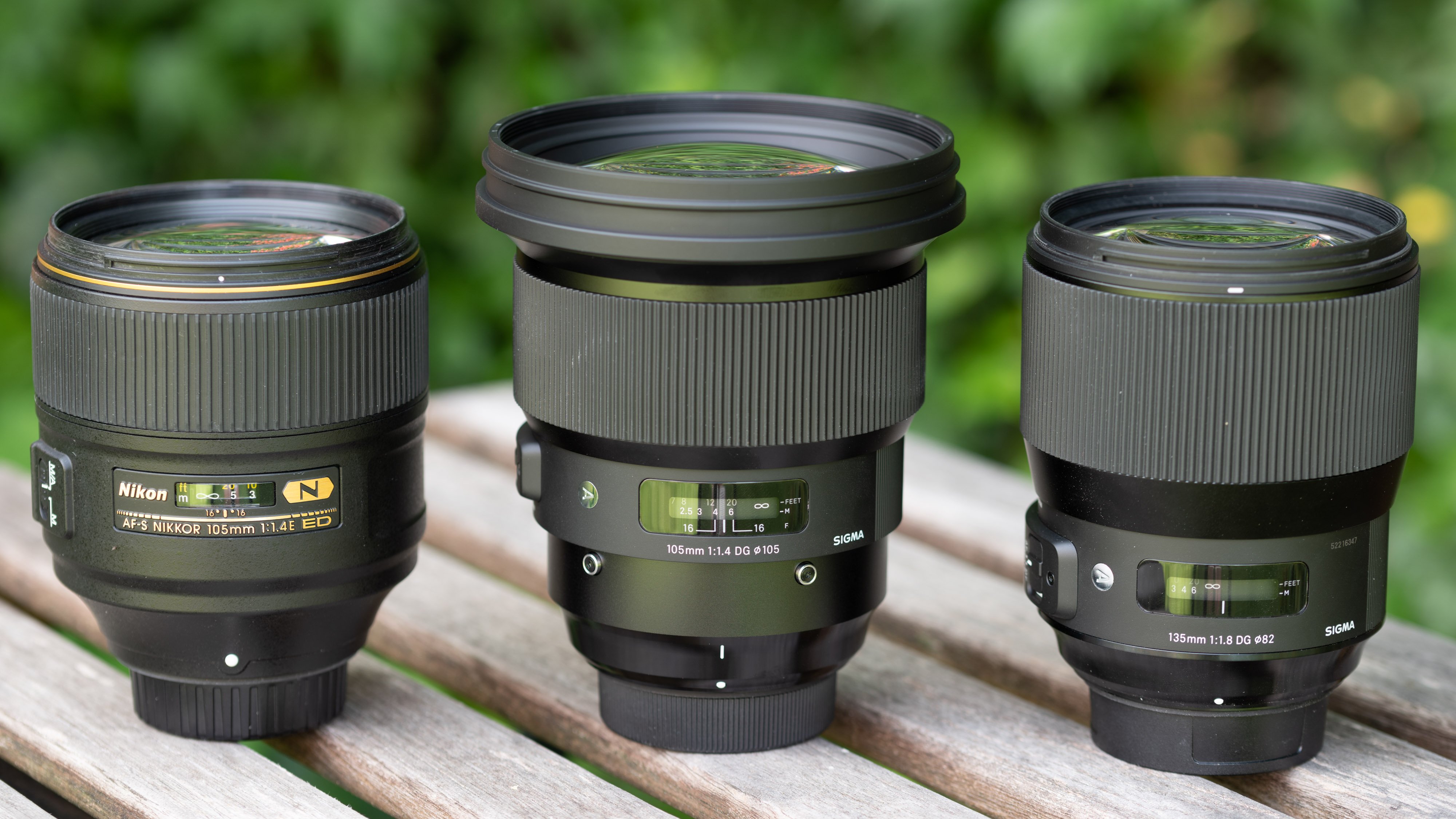
Above from left to right: Nikon 105mm f1.4E ED, Sigma 105mm f1.4 Art, Sigma 135mm f1.8 Art
Alternatives:
- There is really only one other 105mm f1.4 lens: Nikon’s 105mm f1.4E ED from their line of professional large aperture primes. This lens has very good image quality and is smaller and substantially lighter than the new Sigma. But it costs around 2000 EUR. For more details see my Nikon 105mm f1.4E ED review.
- If you go longer then there’s the option of Sigma’s own 135mm f1.8 Art lens. It has 30% more reach which might be a tad too long for your purposes and has a smaller focal ratio (2/3 of a stop). It has the benefit of being lighter and smaller than Sigma’s new 105mm f1.4 and is slightly cheaper plus offers an excellent optical performance. For more details see my Sigma 135mm f1.8 Art review.
- Sony also offers the older SAL 135mm f1.8 ZA Carl Zeiss Sonnar T* from 2006 for A-Mount or via an adapter for E-Mount. It has autofocus but relies on the body to provide the AF-drive. It’s around 1500 EUR. Tests indicate that it’s a very good performer albeit with some serious longitudinal CAs. It’s smaller and lighter than the Sigma and uses 77mm filters. It does not offer image stabilization of its own (like any of the other lenses mentioned) but you have the advantage of the stabilization that the Sony bodies offer. But that is true for the Sigma 105mm f1.4 Art too when you use it on a Sony mirrorless body.
- On the shorter side there is an abundance of 85mm f1.4 lenses of which perhaps the only stabilized lens in this group, the Canon EF 85mm 1.4 L IS USM for around 1550 EUR and the optically excellent and equally expensive Zeiss Otus (manual focus only, 4000 EUR) deserve special mentioning. See my Zeiss Otus 85mm f1.4 review. But you lose 20% reach with a 85mm lens as compared to 105mm focal length which is equivalent to cropping 35% of your pixels away. Sony owners should also consider the Sony FE 85mm f1.4 G Master which performs very well, although costs a little more than the Sigma.
Which focal length do you need?
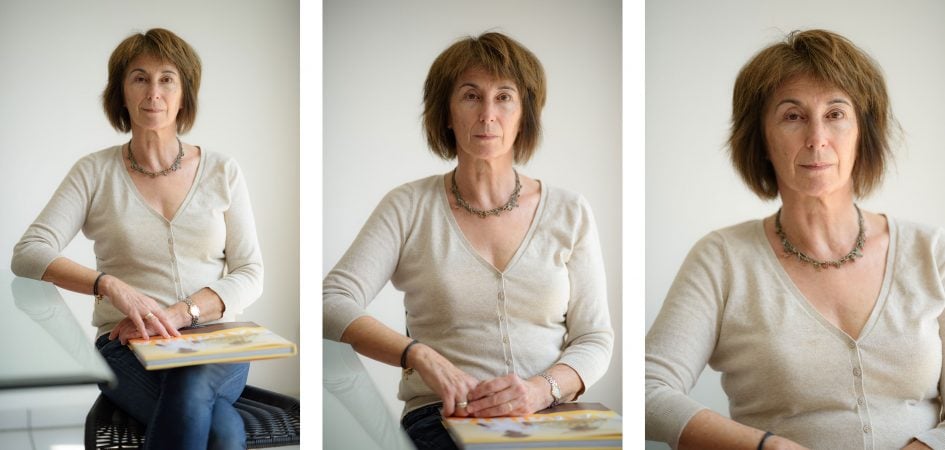
Above from left to right: 85mm, 105mm, 135mm shot from 2.6m distance on a FF/FX-body
Focus
Focus accuracy and repeatability is critical to consistently produce sharp shots. Repeatability (the accuracy of focus on the same subject after repeated focus-acquisition) of this lens is pretty good (measured 97.8% in Reikan FoCal) with no outliers over a series of 40 shots. But this is only when the lens is already focused close to the target distance. With a larger focus movement repeatability sank to 94,3% but still produced no real outliers. And there is a bit of performance variation whether the lens focuses from infinity or from a closer distance.
The lens focuses quite fast in around 0.6 sec from infinity to a magnification of 1:10 without hunting which is faster than the Nikon 105mm f1.4E with 0.8 sec but a bit slower than the Sigma 135mm f1.8 Art at 0.5 sec. The focus ring has no slack/play between its movement and the focus-action and a throw of 135 degrees, which is very good for accurate manual focus wide open. The focus ring offers a good grip with a 33mm broad rubber surface but its movement is a bit too stiff to be comfortably operated with a single finger. It turns the same way as Canon lenses but that is the wrong way for Nikon users. AF-operation is barely audible from the outside and if you record video with the built-in microphone there’s only a “tap” at the beginning and the end of focus-movement and the AF-drive is very quiet. As you pull focus, you’ll clearly notice focus breathing: the image becomes more magnified at closer focusing distances. When I adjusted the focus from infinity to 1.18m on the new Sigma, I measured a 13% increase in magnification which might not please videographers. But the Sigma 135mm f1.8 increases magnification by 18% and the Nikon 105mm f1.4E even by 28%.
Next check out my quality results.
Check prices on the Sigma 105mm f1.4 Art at Amazon, B&H, Adorama, or Wex. Alternatively get yourself a copy of my In Camera book or treat me to a coffee! Thanks!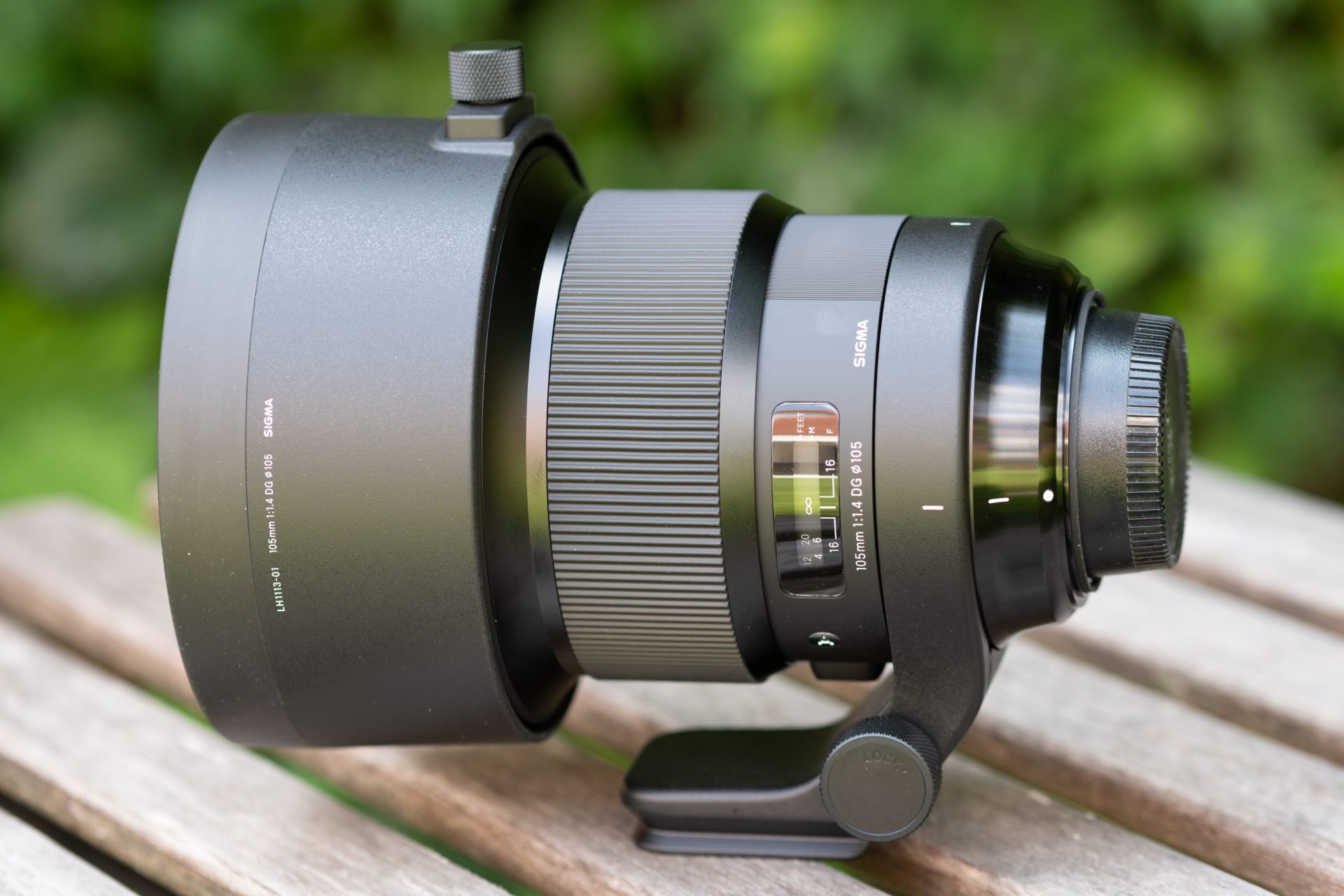
 With the 105mm f1.4 ART, Sigma has produced one of their finest lenses in their acclaimed Art line: it's extra sharp and has the most beautiful Bokeh I've ever seen. Plus it's the only f1.4 105mm lens you can get for your Canon DSLR or Sony mirrorless camera. It might be on the large and very heavy side and has no optical stabilization but its optical performance makes the new Sigma replace the Nikon 105mm f1.4E as the reference large aperture 105mm lens. Thus the Sigma 105mm f1.4 Art easily earns a Highly Recommended.
With the 105mm f1.4 ART, Sigma has produced one of their finest lenses in their acclaimed Art line: it's extra sharp and has the most beautiful Bokeh I've ever seen. Plus it's the only f1.4 105mm lens you can get for your Canon DSLR or Sony mirrorless camera. It might be on the large and very heavy side and has no optical stabilization but its optical performance makes the new Sigma replace the Nikon 105mm f1.4E as the reference large aperture 105mm lens. Thus the Sigma 105mm f1.4 Art easily earns a Highly Recommended.



